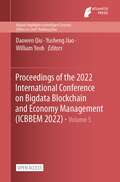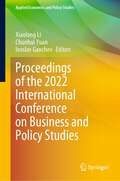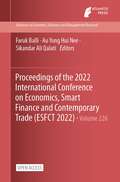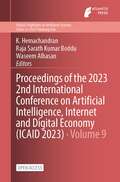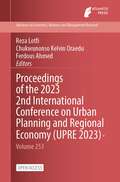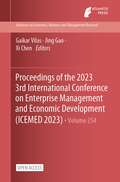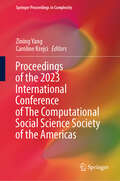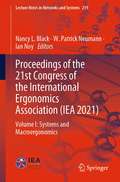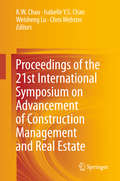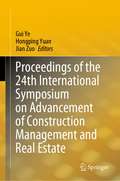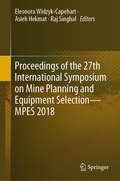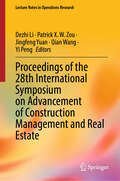- Table View
- List View
Proceedings of the 2022 International Conference on Bigdata Blockchain and Economy Management (Atlantis Highlights in Intelligent Systems #5)
by Daowen Qiu Yusheng Jiao William YeohThis is an open access book.As a leading role in the global megatrend of scientific innovation, China has been creating a more and more open environment for scientific innovation, increasing the depth and breadth of academic cooperation, and building a community of innovation that benefits all. These endeavors have made new contribution to globalization and creating a community of shared future.With the rapid development of modern economic society, in the process of economic management, informatization has become the mainstream of economic development in the future. At the same time, with the emergence of advanced management technologies such as blockchain technology and big data technology, real market information can be quickly obtained in the process of economic management, which greatly reduces the operating costs of the market economy and effectively enhances the management level of operators, thus contributing to the sustained, rapid and healthy development of the market economy. Under the new situation, the innovative application of economic management research is of great practical significance. 2022 International Conference on Bigdata, Blockchain and Economic Management (ICBBEM 2022) will be held on March 25–27, 2022 in Wuhan, China. ICBBEM 2022 will focus on the latest fields of Bigdata, Blockchain and Economic Management to provide an international platform for experts, professors, scholars and engineers from universities, scientific institutes, enterprises and government-affiliated institutions at home and abroad to share experiences, to expand professional fields, to exchange new ideas face to face, to present research results, and to discuss the key challenging issues and research directions facing the development of this field, with a view to promoting the development and application of theories and technologies in universities and enterprises.
Proceedings of the 2022 International Conference on Business and Policy Studies (Applied Economics and Policy Studies)
by Xiaolong Li Chunhui Yuan Ivoslav GanchevThis proceedings volume contains papers accepted by the 2022 International Conference on Business and Policy Studies (CONF-BPS 2022), which are carefully selected and reviewed by professional reviewers from corresponding research fields and the editorial team of the conference. This volume presents latest research achievements, inspirations, and applications in applied economy, finance, enterprise management, public administration, and policy studies. CONF-BPS hopes this volume could be inspiring and of academic value.Business and policy studies both are heated research topics and are related to multiple fields. Held by Eliwise Academy, CONF-BPS aims at bringing together intellectuals from related fields including applied economy, finance, and public administration for academic exchange. Its goal is to serve as an international platform for researchers to present latest research progress, share ideas and inspirations, and exchange experience. Through more academic communication and exchange, this conference hops to promote international corporation and joint initiatives in relevant fields. This volume will be of interest to researchers, academics, professionals, and policy makers in the field of business, economics, management, and policy studies.
Proceedings of the 2022 International Conference on Economics, Smart Finance and Contemporary Trade (Advances in Economics, Business and Management Research #663)
by Faruk Balli Au Yong Hui Nee Sikandar Ali QalatiThis is an open access book.As a leading role in the global megatrend of scientific innovation, China has been creating a more and more open environment for scientific innovation, increasing the depth and breadth of academic cooperation, and building a community of innovation that benefits all. Such endeavors are making new contributions to the globalization and creating a community of shared future.To adapt to this changing world and China's fast development in the new era, The 2022 International Conference on Economics, Smart Finance and Contemporary Trade to be held in July 2022. This conference takes "bringing together global wisdom in scientific innovation to promote high-quality development" as the theme and focuses on cutting-edge research fields including Economics, Smart Finance and Contemporary Trade. This conference aims to boost development of the Greater Bay Area, expand channels of international academic exchange in science and technology, build a sharing platform of academic resources, promote scientific innovation on the global scale, strengthen academic cooperation between China and the outside world, enhance development of new energy and materials and IT, AI, and biomedicine industries. It also aims to encourage exchange of information on frontiers of research in different areas, connect the most advanced academic resources in China and the world, turn research results into industrial solutions, and bring together talents, technologies and capital to boost development.
Proceedings of the 2022 International Symposium on Energy Management and Sustainability: ISEMAS 2022 (Springer Proceedings in Energy)
by M. Ziya Sogut T. Hikmet Karakoc Omer Secgin Alper DalkiranThe International Symposium on Energy Management and Sustainability (ISEMAS) is a multi-disciplinary symposium that presents research on current issues in energy efficiency, social awareness, and global climate change. The conference provides a platform offering insights on the latest trends and innovations in energy management and the impact of sustainability on energy management processes. In this context, it aims to bring together sectoral, scientific, and demand-related elements in the field of energy. ISEMAS allows researchers, scientists, engineers, practitioners, policymakers, and students to exchange information, present new technologies and developments, and discuss future direction, strategies and priorities that improve environmental sustainability.
Proceedings of the 2023 2nd International Conference on Artificial Intelligence, Internet and Digital Economy (Atlantis Highlights in Intelligent Systems #9)
by K. Hemachandran Raja Sarath Kumar Boddu Waseem AlhasanThis is an open access book. With the continuous upgrading of network information technology, especially the combination of Internet - cloud computing - blockchain - Internet of things and other information technologies with social and economic activities, through the improvement of artificial intelligence, Internet and big data with high quality and fast processing efficiency, the economic form is transformed from industrial economy to information economy. This will greatly reduce social transaction costs, improve the efficiency of resource optimization, increase the added value of products, enterprises and industries, and promote the rapid development of social productivity. 2023 2nd International Conference on Artificial Intelligence, the Internet and the Digital Economy (ICAID 2023) will continue to focus on the latest research on "Artificial intelligence, the Internet and the Digital Economy", and expand the research on "technology and application of the integrated development of Digital Economy and Artificial Intelligence" as the theme. The aim is to gather experts, scholars, researchers and related practitioners from around the world to share research results, discuss hot issues, and provide participants with cutting-edge technology information so that they can keep abreast of industry developments, the latest technologies and broaden their research horizons.The conference was held in Beijing, China on April 21-23, 2023. All experts and scholars are welcome to attend.
Proceedings of the 2023 2nd International Conference on Urban Planning and Regional Economy (Advances in Economics, Business and Management Research #253)
by Reza Lotfi Chukwunonso Kelvin Oraedu Ferdous AhmedThis is an open access book.As a leading role in the global megatrend of scientific innovation, China has been creating a more and more open environment for scientific innovation, increasing the depth and breadth of academic cooperation, and building a community of innovation that benefits all. These endeavors have made new contribution to globalization and creating a community of shared future.To adapt to this changing world and China's fast development in this new era, 2023 2nd International Conference on Urban Planning and Regional Economy (UPRE 2023) is to be held on April 21-23, 2023 in Beijing, China. Urban planning can change the functional structure of a city. Urban planning plays a very important role in regional economic development. Urban planning contains various factors of urban economic development. Urban economic development can effectively improve the speed and quality of urban planning formulation and implementation. The two affect and interact with each other. The meeting will focus on "urban planning" and "regional economy", and discuss their interdependence, mutual promotion and mutual restriction.UPRE 2023 aims to build a platform for scholars to discuss the relationship between urban planning and economy, aims to promote the exchange of different cutting-edge research in the field of information and connection at home and abroad the most advanced academic resources. Conference topics include Traffic management and supply chain, regional policy and local economic transformation, Scenic spot development and tourism economy, Urban modernization and high-tech economy, Environmental protection and sustainable economy, Resource development and industrial structure.
Proceedings of the 2023 3rd International Conference on Enterprise Management and Economic Development (Advances in Economics, Business and Management Research #254)
by Gaikar Vilas Jing Gao Xi ChenThis is an open access book.2023 3rd International Conference on Enterprise Management and Economic Development (ICEMED2023) will be held in Xi'an, China on May 12–14, 2023.Enterprise management is the general term for a series of functions such as organizing, planning, commanding, supervising and regulating the production and operation activities of enterprises.Relative to economic growth, economic development is the core concept of development economics. Economic development refers to the high-quality development of the economy, including quality and quantity, rather than merely the growth of quantity.Enterprise management covers economics, management, business management, financial management, human resource management and other aspects, and is a comprehensive interdisciplinary science that spans natural science, engineering science, technical science and humanities and social science. Enterprise management comes into being with the development of modern socialized mass production. The use of modern management means and methods to manage enterprises, ensure the survival and development of enterprises, and play a positive role in promoting economic development.ICEMED2023 will bring together experts and scholars from relevant fields to discuss the relationship between enterprise management and economic development. Reasonable enterprise management is an important way to promote the economic development of enterprises. Scientific and reasonable use of industrial and commercial enterprise management knowledge can reasonably carry out effective macro-control on the enterprise economy and ensure the stable progress and development of the enterprise economy.
Proceedings of the 2023 4th International Conference on Education, Knowledge and Information Management (Atlantis Highlights in Computer Sciences #13)
by Xueming Yuan Yohannes Kurniawan Zhenyan JiThis is an open access book.With the successful experience of the past 3 years, we believe that the 2023 4th International Conference on Education, Knowledge and Information Management (ICEKIM 2023) will be an even greater success in 2023, and welcome all scholars and experts to submit their papers for the conference!The 2023 4th International Conference on Education, Knowledge and Information Management (ICEKIM 2023) will be held on January 13-15, 2023 in Zhengzhou, China. In the era of information explosion, there is no doubt that education is an important way of knowledge production, dissemination and diffusion. Education plays an important role in promoting human development and promoting the development of society and human knowledge. ICEKIM 2023 is to bring together innovative academics and industrial experts in the field of Education, Knowledge and Information Management to a common forum. The primary goal of the conference is to promote research and developmental activities in Education, Knowledge and Information Management and another goal is to promote scientific information interchange between researchers, developers, engineers, students, and practitioners working all around the world. The conference will be held every year to make it an ideal platform for people to share views and experiences in international conference on Education, Knowledge and Information Management and related areas.
The Proceedings of the 2023 Conference on Systems Engineering Research: Systems Engineering Towards a Smart and Sustainable World (Conference on Systems Engineering Research Series)
by Dinesh Verma Azad M. Madni Steven Hoffenson Lu XiaoThe 20th International Conference on Systems Engineering Research (CSER 2023) pushes the boundaries of systems engineering research and responds to new challenges for systems engineering. CSER 2023 invited researchers and practitioners to submit their work in alignment with the thematic focus on a smart and sustainable world. CSER was founded in 2003 by Stevens Institute of Technology and the University of Southern California, and in 2023 the conference returned to the Stevens campus in Hoboken, New Jersey.
Proceedings of the 2023 International Conference of The Computational Social Science Society of the Americas (Springer Proceedings in Complexity)
by Zining Yang Caroline KrejciThis book contains a selection of the latest research in the field of Computational Social Science (CSS) methods, uses, and results, as presented at the 2023 annual conference of the Computational Social Science Society of the Americas (CSSSA). This conference is held in Santa Fe, New Mexico, November 2–5, 2023. CSS is the science that investigates social and behavioral dynamics through social simulation, social network analysis, and social media analysis. The CSSSA is a professional society that aims to advance the field of computational social science in all areas, including basic and applied orientations, by holding conferences and workshops, promoting standards of scientific excellence in research and teaching, and publishing research findings and results.
Proceedings of the 20th International Symposium on Management (Advances in Economics, Business and Management Research #256)
by Werner Ria Murhadi Dudi Anandya Noviaty Kresna Darmasetiawan Juliani Dyah Trisnawati Putu Anom Mahadwartha Elsye TandelilinThis is an open access book. With the rapid advancement of augmented reality, blockchain, and the internet, the metaverse is now within reach like never before. Companies are continuously pushing the boundaries of innovation to cater to the ever-evolving needs of consumers. They employ a diverse range of strategies to elevate the value of their products and stay ahead of the competition. However, not every company manages to achieve this feat, often due to resource limitations and the ability to understand dynamic market trends.The 20th INSYMA (International Symposium on Management) is bringing you further into the metaverse. This year’s theme is “The Metaverse and Beyond: Opportunity or Disaster? New Realities In Workplaces.
Proceedings of the 21st Congress of the International Ergonomics Association: Volume IV: Healthcare and Healthy Work (Lecture Notes in Networks and Systems #222)
by Nancy L. Black W. Patrick Neumann Ian NoyThis book presents the proceedings of the 21st Congress of the International Ergonomics Association (IEA 2021), held online on June 13-18, 2021. By highlighting the latest theories and models, as well as cutting-edge technologies and applications, and by combining findings from a range of disciplines including engineering, design, robotics, healthcare, management, computer science, human biology and behavioral science, it provides researchers and practitioners alike with a comprehensive, timely guide on human factors and ergonomics. It also offers an excellent source of innovative ideas to stimulate future discussions and developments aimed at applying knowledge and techniques to optimize system performance, while at the same time promoting the health, safety and wellbeing of individuals. The proceedings include papers from researchers and practitioners, scientists and physicians, institutional leaders, managers and policy makers that contribute to constructing the Human Factors and Ergonomics approach across a variety of methodologies, domains and productive sectors. This volume includes papers addressing the following topics: Healthcare Ergonomics, Health and Safety, Musculoskeletal Disorders, HF/E Contribution to cope with Covid-19.
Proceedings of the 21st Congress of the International Ergonomics Association: Volume III: Sector Based Ergonomics (Lecture Notes in Networks and Systems #221)
by Nancy L. Black W. Patrick Neumann Ian NoyThis book presents the proceedings of the 21st Congress of the International Ergonomics Association (IEA 2021), held online on June 13-18, 2021. By highlighting the latest theories and models, as well as cutting-edge technologies and applications, and by combining findings from a range of disciplines including engineering, design, robotics, healthcare, management, computer science, human biology and behavioral science, it provides researchers and practitioners alike with a comprehensive, timely guide on human factors and ergonomics. It also offers an excellent source of innovative ideas to stimulate future discussions and developments aimed at applying knowledge and techniques to optimize system performance, while at the same time promoting the health, safety and wellbeing of individuals. The proceedings include papers from researchers and practitioners, scientists and physicians, institutional leaders, managers and policy makers that contribute to constructing the Human Factors and Ergonomics approach across a variety of methodologies, domains and productive sectors. This volume includes papers addressing the following topics: Transport Ergonomics and Human Factors, Practitioner Case Studies, Human Factors in Robotics, Manufacturing, Agriculture, HF/E in Supply Chain Design and Management, Aerospace, Building and Construction.
Proceedings of the 21st Congress of the International Ergonomics Association: Volume V: Methods & Approaches (Lecture Notes in Networks and Systems #223)
by Nancy L. Black W. Patrick Neumann Ian NoyThis book presents the proceedings of the 21st Congress of the International Ergonomics Association (IEA 2021), held online on June 13-18, 2021. By highlighting the latest theories and models, as well as cutting-edge technologies and applications, and by combining findings from a range of disciplines including engineering, design, robotics, healthcare, management, computer science, human biology and behavioral science, it provides researchers and practitioners alike with a comprehensive, timely guide on human factors and ergonomics. It also offers an excellent source of innovative ideas to stimulate future discussions and developments aimed at applying knowledge and techniques to optimize system performance, while at the same time promoting the health, safety and wellbeing of individuals. The proceedings include papers from researchers and practitioners, scientists and physicians, institutional leaders, managers and policy makers that contribute to constructing the Human Factors and Ergonomics approach across a variety of methodologies, domains and productive sectors. This volume includes papers addressing the following topics: Working with Computer Systems, Human Modelling and Simulation, Neuroergonomics, Biomechanics, Affective Design, Anthropometry, Advanced Imaging.
Proceedings of the 21st Congress of the International Ergonomics Association: Volume II: Inclusive Design (Lecture Notes in Networks and Systems #220)
by Nancy L. Black W. Patrick Neumann Ian NoyThis book presents the proceedings of the 21st Congress of the International Ergonomics Association (IEA 2021), held online on June 13-18, 2021. By highlighting the latest theories and models, as well as cutting-edge technologies and applications, and by combining findings from a range of disciplines including engineering, design, robotics, healthcare, management, computer science, human biology and behavioral science, it provides researchers and practitioners alike with a comprehensive, timely guide on human factors and ergonomics. It also offers an excellent source of innovative ideas to stimulate future discussions and developments aimed at applying knowledge and techniques to optimize system performance, while at the same time promoting the health, safety and wellbeing of individuals. The proceedings include papers from researchers and practitioners, scientists and physicians, institutional leaders, managers and policy makers that contribute to constructing the Human Factors and Ergonomics approach across a variety of methodologies, domains and productive sectors. This volume includes papers addressing the following topics: Ergonomics in Design for All, Human Factors and Sustainable Development, Gender and Work, Slips Trips and Falls, Visual Ergonomics, Ergonomics for children and Educational Environments, Ageing and Work.
Proceedings of the 21st Congress of the International Ergonomics Association: Volume I: Systems and Macroergonomics (Lecture Notes in Networks and Systems #219)
by Nancy L. Black W. Patrick Neumann Ian NoyThis book presents the proceedings of the 21st Congress of the International Ergonomics Association (IEA 2021), held online on June 13-18, 2021. By highlighting the latest theories and models, as well as cutting-edge technologies and applications, and by combining findings from a range of disciplines including engineering, design, robotics, healthcare, management, computer science, human biology and behavioral science, it provides researchers and practitioners alike with a comprehensive, timely guide on human factors and ergonomics. It also offers an excellent source of innovative ideas to stimulate future discussions and developments aimed at applying knowledge and techniques to optimize system performance, while at the same time promoting the health, safety and wellbeing of individuals. The proceedings include papers from researchers and practitioners, scientists and physicians, institutional leaders, managers and policy makers that contribute to constructing the Human Factors and Ergonomics approach across a variety of methodologies, domains and productive sectors. This volume includes papers addressing the following topics: Activity Theories for Work Analysis and Design (ATWAD), Organisation design and management (ODAM), Ergonomic Work Analysis and Training (EWAT), Systems HF/E, HF/E Education and Professional Certification Development.
Proceedings of the 21st International Symposium on Advancement of Construction Management and Real Estate
by K. W. Chau Weisheng Lu Chris Webster Isabelle Y.S. ChanThis book presents the proceedings of CRIOCM_2016, 21st International Conference on Advancement of Construction Management and Real Estate, sharing the latest developments in real estate and construction management around the globe. The conference was organized by the Chinese Research Institute of Construction Management (CRIOCM) working in close collaboration with the University of Hong Kong. Written by international academics and professionals, the proceedings discuss the latest achievements, research findings and advances in frontier disciplines in the field of construction management and real estate. Covering a wide range of topics, including building information modelling, big data, geographic information systems, housing policies, management of infrastructure projects, occupational health and safety, real estate finance and economics, urban planning, and sustainability, the discussions provide valuable insights into the implementation of advanced construction project management and the real estate market in China and abroad. The book is an outstanding reference resource for academics and professionals alike.
Proceedings of the 22nd International Conference on Industrial Engineering and Engineering Management 2015
by Runliang Dou Jiang Shen Ershi QiBeing the premier forum for the presentation of new advances and research results in the fields of Industrial Engineering, IEEM 2015 aims to provide a high-level international forum for experts, scholars and entrepreneurs at home and abroad to present the recent advances, new techniques and applications face and face, to promote discussion and interaction among academics, researchers and professionals to promote the developments and applications of the related theories and technologies in universities and enterprises, and to establish business or research relations to find global partners for future collaboration in the field of Industrial Engineering. All the goals of the international conference are to fulfill the mission of the series conference which is to review, exchange, summarize and promote the latest achievements in the field of industrial engineering and engineering management over the past year, and to propose prospects and vision for the further development. This volume is the first of the two proceedings volumes from this conference.
Proceedings of the 23rd International Symposium on Advancement of Construction Management and Real Estate
by Fenjie Long Sheng Zheng Yuzhe Wu Gangying Yang Yan YangThis book presents the proceedings of CRIOCM2018, 23rd International Symposium on Advancement of Construction Management and Real Estate, sharing the latest developments in real estate and construction management around the globe. The conference was organized by the Chinese Research Institute of Construction Management (CRIOCM) working in close collaboration with Guizhou Institute of Technology (GIT). Written by international academics and professionals, the proceedings discuss the latest achievements, research findings and advances in frontier disciplines in the field of construction management and real estate. Covering a wide range of topics, including New-type urbanization, land development and land use, urban planning and infrastructure construction, housing market and housing policy, real estate finance and investment, new theories and practices on construction project management, smart city, BIM technologies and applications, construction management in big data era, green architecture and eco-city, rural rejuvenation and eco-civilization, other topics related to construction management and real estate, the discussions provide valuable insights into the advancement of construction management and real estate in the new era. The book is an outstanding reference resource for academics and professionals alike.
Proceedings of the 24th International Symposium on Advancement of Construction Management and Real Estate
by Jian Zuo Gui Ye Hongping YuanThis book covers various current and emerging topics in construction management and real estate. Papers selected in this book cover a wide variety of topics such as new-type urbanization, planning and construction of smart city and eco-city, urban–rural infrastructure development, land use and development, housing market and housing policy, new theory and practice of construction project management, big data application, smart construction and BIM, international construction (i.e., belt and road project), green building, off-site prefabrication, rural rejuvenation and eco-civilization and other topics related to construction management and real estate. These papers provide useful references to both scholars and practitioners. This book is the documentation of “The 24th International Symposium on Advancement of Construction Management and Real Estate,” which was held in Chongqing, China.
Proceedings of the 25th International Symposium on Advancement of Construction Management and Real Estate
by Xinhai Lu Zuo Zhang Weisheng Lu Yi PengThis proceedings book focuses on innovation, cooperation, and sustainable development in the fields of construction management and real estate. The book provides a detailed analysis and description of the disciplinary frontiers in the field of building management and real estate and how they can be promoted in the context of the epidemic. A wide variety of papers provide a reference value for both scholars and practitioners. The proceedings book is the documentation of “the 25th International Symposium on Advancement of Construction Management and Real Estate” (CRIOCM 2020), which was held at the School of Public Administration, Central China Normal University, Wuhan, China, in 2020.
Proceedings of the 26th International Symposium on Advancement of Construction Management and Real Estate (Lecture Notes in Operations Research)
by Yi Peng Weisheng Lu Hongling Guo Dongping FangThis book of CRIOCM 2021 (26th International Conference on Advancement of Construction Management and Real Estate) presents the latest developments in real estate and construction management around the globe. The conference was organized by the Chinese Research Institute of Construction Management (CRIOCM) working in close collaboration with Tsinghua University. Written by international academics and professionals, the book discusses the latest achievements, research findings and advances in frontier disciplines in the field of construction management and real estate. Covering a wide range of topics, including building information modeling, big data, geographic information systems, housing policies, management of infrastructure projects, intelligent construction and smart city, real estate finance and economics and urban planning and sustainability, the discussions provide valuable insights into the implementation of advanced construction project management and real estate market in China and abroad. The book offers an outstanding resource for academics and professionals.
Proceedings of the 27th International Symposium on Advancement of Construction Management and Real Estate (Lecture Notes in Operations Research)
by Jing Li Weisheng Lu Yi Peng Hongping Yuan Daikun WangThis book presents the proceedings of CRIOCM 2022 (27th International Conference on Advancement of Construction Management and Real Estate), sharing the latest developments in real estate and construction management around the globe. The conference was organized by the Chinese Research Institute of Construction Management (CRIOCM) working in close collaboration with The Chinese University of Hong Kong. Written by international academics and professionals, the book discusses the latest achievements, research findings, and advances in frontier disciplines in the field of construction management and real estate. Covering a wide range of topics, including spatial planning and land use innovation, integration and application of BIM and GIS, low-carbon built environment, post-pandemic resilient cities development, housing and social governance, real estate market and urban policy, real estate finance and economics, intelligent construction and smart city, built environment for healthy living, and construction management in the post-COVID-19 era, the discussions provide valuable insights into the implementation of advanced construction project management and real estate market in China and abroad. The book offers an outstanding resource for academics and professionals
Proceedings of the 27th International Symposium on Mine Planning and Equipment Selection - MPES 2018
by Eleonora Widzyk-Capehart Asieh Hekmat Raj SinghalThis proceedings book presents research papers discussing the latest developments and findings in the fields of mining, machinery, automation and environmental protection. It includes contributions from authors from over 20 countries, with backgrounds in computer science, mining engineering, technology and management, and hailing from the government, industry and academia. It is of interest to scientists, engineers, consultants and government staff who are responsible for the development and implementation of innovative approaches, techniques and technologies in the mineral industries. Covering the latest advances in fundamental research, it also appeals to academic researchers.
Proceedings of the 28th International Symposium on Advancement of Construction Management and Real Estate (Lecture Notes in Operations Research)
by Dezhi Li Patrick X. W. Zou Jingfeng Yuan Qian Wang Yi PengThis book presents the proceedings of CRIOCM 2023, sharing the latest developments in real estate and construction management around the globe. The conference was organized by the Chinese Research Institute of Construction Management (CRIOCM) and Southeast University. Written by international academics and professionals, the proceedings discuss the latest achievements, research findings and advances in frontier disciplines in the field of construction management and real estate, covering a wide range of topics, including new theory and practice of engineering management, smart construction and maintenance, green low-carbon building and sustainable development, big data and blockchain, construction and real estate economy, real estate finance and investment, real estate management and housing policy, innovative theory and practice of urban governance, land use and urban planning, and other related issues. The discussions provide valuable insights into the implementation of advanced construction project management and real estate market in China and abroad. The book offers an outstanding resource for academics and professionals.
